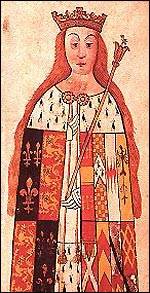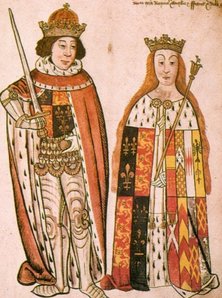Despite their childhood friendship and their affection for each other you cannot dismiss the fact that this inheritance played a big part in the marriage arrangements of Richard Duke of Gloucester to Anne and his brother George Duke of Clarence to Isabel.
|
The 11th June 1456, the birth of Anne Neville, daughter of Richard, Earl of Warwick and Anne Beauchamp and sister of Isabel. On the death of their father at the Battle of Barnet in 1471 they would become heiresses, not only of the Neville inheritance, but of the vast Beauchamp estates.
Despite their childhood friendship and their affection for each other you cannot dismiss the fact that this inheritance played a big part in the marriage arrangements of Richard Duke of Gloucester to Anne and his brother George Duke of Clarence to Isabel.
0 Comments
I am always a little sad when it comes round to the 16th March, and the anniversary of the death of Anne Neville. This is because it is so difficult to find facts about her other than she was the wife of Richard III, daughter of the King Maker, an heiress to a vast estate and dead at twenty-eight under a solar eclipse so the story goes. If I cannot find the real Anne Neville in words, then I can find her in art, and Edwin Austin Abbey's 1896 painting Richard Duke of Gloucester and Lady Anne does just that. I really love this painting. I love it even though it depicts Richard as the hunchbacked villain we know he wasn't. For me, this painting is all about Anne, see how beautifully she is drawn. Anne looks confident and determined, she is striding and moving fast in a effort to keep her distance from Gloucester, just look at how her black mourning veil covers the whole of her colourful, ermine edged dress. But what I find most interesting is, at first glance it appears that it is Anne who holds the halberd, when it is in fact the guard behind her, she is holding it as if she will do away with Gloucester with one stab of its blade. We know that Anne didn't hate Richard, that was Shakespeare's take on their story. We also know that Richard and Anne were acquainted in childhood, they were two people who were comfortable with one another whose marriage, had it continued, might have been a successful and happy one. In this one moment, perhaps we can see the real Anne Neville, not the mouse of a women we are lead to believe she was. Anne had been married, at just fourteen, to the heir to the throne of England, the son of Henry VI and Margaret of Anjou for just five months and widowed in the May of 1471. She soon married Richard, Duke of Gloucester and their son Edward, born in the December of 1473 was dead by the age of ten. Like a lot of medieval women, Anne's private life has passed undocumented, only the facts that linked her to the main events of the time are written of, leaving very little of her for us to get to know. At not yet twenty nine, Anne died on the 16th March 1485. According to Oppolzer's Canon of Eclipses on the 16th March 1485, the whole of southern Europe experienced a total solar eclipse. If Anne's death, wasn't devastating enough for Richard, then the blackening of the sun must have filled him with extreme foreboding, after all, the phenomenon of three suns, known as a Parhelion, that appeared at the battle of Mortimer's Cross in 1461 had been an inspiration to the troops and seen by his brother, the future Edward IV, as a good omen on his future reign. How very significant this eclipse must have been for poor Richard.
Anne died probably of tuberculous and is buried at Westminster Abbey by the High Altar, no doubt Richard intended a grand monument in her honour, but because of his tragic death at Bosworth five months later her grave was left unmarked, it was ignored by the new Tudor king, possibly in an effort to wipe her from history as he did with Richard III. Standing proudly in the Fenlands of Lincolnshire are the ruins of the Abbey of Crowland, and as autumn brings its misty evenings, or winter its frozen crisp mornings, standing among the abbeys broken arches you cannot help but think of the forthcoming Christmas festivities. At the beginning of December, Crowland Abbey joins in the fun of Christmas just like any other religious establishment, usually in the first week of December it has its Christmas Craft and Food Fare when mince pies are eaten and maybe a drink of mulled wine is sampled. On the 6th December in 1484, the second Christmas of King Richard III's reign and just like today people celebrated, for this day was St Nicholas's saints day. On that day, our ancestors believed this Saint Nicholas brought gifts such as nuts, fruits and marzipan sweets, and with these gifts the ability to foretell the events of the following year. While most of the Fenland community where knocking back the Christmas ale, Crowland Abbey was not so festive. Within the abbey the monks were busy with local and national affairs, on one hand they were trying to keep talk of a local dispute quiet and on the other being quite vocal in its criticism of Christmas in the court of King Richard III. Whoever it was that put ink to parchment, had much to say on the subject of the shenanigans going on at Richard's Christmas parties. The writer of the famous Croyland Chronicle states that he was unable to account for many of the activities in the court at this time “because it is shameful to speak of them” even Queen Anne and Elizabeth of York were considered "vain" because they had more than one party outfit. Richards best buddy, Bishop Thomas Langton, joined these medieval party poopers by stating "sensual pleasure holds sway to an increasing extent.’ What on earth did this mean? Did Richard kiss the lovely Ann more than once under the misletoe I wonder? Not one of the writers made any attempt to elaborate on any of the events they were writing about. All the criticisms of Richards "wild parties" came from the clergy who were very quick to point out that Richard saw himself as a "good, learned, serious and virtuous man" while also pointing out that he had called his brothers court "licentious and morally corrupt." The University of Leicester School of Historical Studies quite rightly pointed out that compared with the wild parties that were held at Rome during the reign of Pope Alexander VI, the English court under Edward IV and Richard III was a 'model of virtue.’ Surely, even the pious, like Richard, should not be frowned upon for having a good time, obviously there was more to these statements than meets the eye. Perhaps these people were just a tad miffed and just bit disgruntled at not to being invited. Did they watch from a distance or listen enviously to tales told the following morning of how Catesby, Lovell and Ratcliffe danced in silly animal party hats or King Richard drank way too ale and threw iced cakes at the clergy. In reality of course, all these damning words were written years later. Those who pooh poohed the kings festivities were not irritated because a invitation hadn't landed on their door mat, they were spouting propaganda, words they thought their new
king wished to hear, words that would keep them safe in the new Tudor era. History suggests that the events at court in 1484, as written in the Croyland Chronicles, were written two years later in 1486, by someone who was educated in law and who was privy to information within the court. The Benedictine residents of Crowland Abbey had at their head one Lambert Fossdyke who had been Abbot at Crowland since January 1484 and who was a Bachelor of Law and it was such a man with a degree in law who was considered to be the writer of these malicious rumors about Richard III. John Russell, Bishop of Lincoln, is commonly thought to be the author but it could just as well have been Fossdyke dictating to one of his monks? |
Categories
All
Archives
May 2024
|








 RSS Feed
RSS Feed
